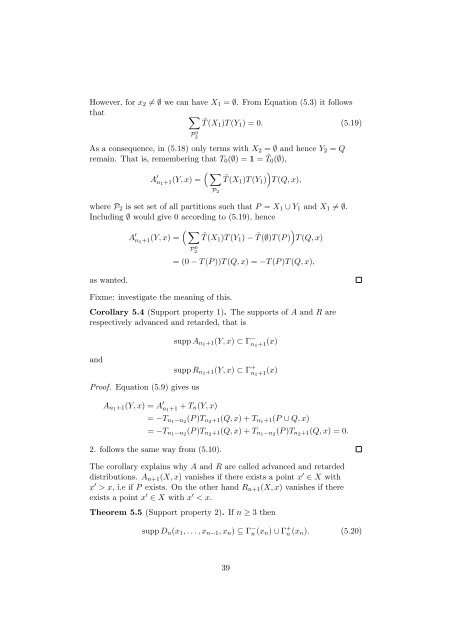Master Dissertation
Master Dissertation
Master Dissertation
Create successful ePaper yourself
Turn your PDF publications into a flip-book with our unique Google optimized e-Paper software.
However, for x2 = ∅ we can have X1 = ∅. From Equation (5.3) it follows<br />
that <br />
˜T (X1)T (Y1) = 0. (5.19)<br />
P 0 2<br />
As a consequence, in (5.18) only terms with X2 = ∅ and hence Y2 = Q<br />
remain. That is, remembering that T0(∅) = 1 = ˜ T0(∅),<br />
A ′ <br />
<br />
n1+1(Y, x) = ˜T (X1)T (Y1) T (Q, x),<br />
P2<br />
where P2 is set set of all partitions such that P = X1 ∪ Y1 and X1 = ∅.<br />
Including ∅ would give 0 according to (5.19), hence<br />
A ′ <br />
n1+1(Y, x) = ˜T (X1)T (Y1) − ˜ <br />
T (∅)T (P ) T (Q, x)<br />
as wanted.<br />
P 0 2<br />
Fixme: investigate the meaning of this.<br />
= (0 − T (P ))T (Q, x) = −T (P )T (Q, x),<br />
Corollary 5.4 (Support property 1). The supports of A and R are<br />
respectively advanced and retarded, that is<br />
and<br />
Proof. Equation (5.9) gives us<br />
An1+1(Y, x) = A ′ n1+1 + Tn(Y, x)<br />
supp An1+1(Y, x) ⊂ Γ − n1+1 (x)<br />
supp Rn1+1(Y, x) ⊂ Γ + n1+1 (x)<br />
= −Tn1−n2 (P )Tn2+1(Q, x) + Tn1+1(P ∪ Q, x)<br />
= −Tn1−n2 (P )Tn2+1(Q, x) + Tn1−n2 (P )Tn2+1(Q, x) = 0.<br />
2. follows the same way from (5.10).<br />
The corollary explains why A and R are called advanced and retarded<br />
distributions. An+1(X, x) vanishes if there exists a point x ′ ∈ X with<br />
x ′ > x, i.e if P exists. On the other hand Rn+1(X, x) vanishes if there<br />
exists a point x ′ ∈ X with x ′ < x.<br />
Theorem 5.5 (Support property 2). If n ≥ 3 then<br />
supp Dn(x1, . . . , xn−1, xn) ⊆ Γ − n (xn) ∪ Γ + n (xn). (5.20)<br />
39



